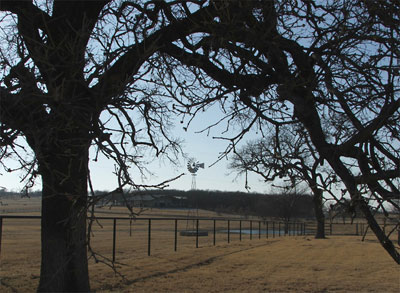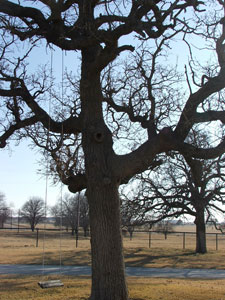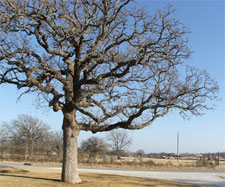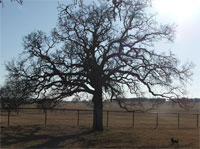Native Son – January, 2009

Silhouettes of post oak (Quercus stellata) frame a windmill in a photo that is pure Texana. Photos by Steven Chamblee.
Post Oak

As soon as my frozen fanny hit the toasty leather, I knew it would be a great, albeit brief, road trip. It was one of those fancy new dually trucks, tough as a boot on the outside and fuzzy as a kitten on the inside … including seat warmers. I purred with delight, the diesel engine roared, and away we went.
Five minutes later — “Buns toasted yet?” asked my chauffeur, a friend of mine whom I’ll just call Nyoka … in an effort to protect the name of the innocent.
“Truth be told, gettin’ a little burned over here,” I replied.
“Wimp.”
Perhaps my favorite thing about living in Weatherford is all the little country roads that constantly beckon for a quickie road trip. We found one and it led to a tiny town named Peaster, then to the front gate of the ranch. Half an hour of arm-waving, vision-building, and pencil-scrawling later, we had the rough draft of a landscape and hit the hot seats again to check out the horses, the deer, and the post oaks.
Post oak (Quercus stellata) is native to sandy soils in the eastern two-thirds of Texas. Botanically named for the tiny “stellate trichomes” (star-shaped plant hairs) on the bottom of the (roughly) cross-shaped leaves, these trees can grow to about 50 feet tall and almost as wide, though most are much smaller. The dark green leaves turn tan color in the fall, and persist on some trees through the winter. Overall, the tree has a rather stout growth habit, akin to that of a bur oak, and is as tough as it is beautiful.

Post oaks are famous for their longevity. There are many 200- to 300-year-old specimens in North Central Texas, and a few individuals that have been scientifically dated to the year 1681. Ironically, the oldest specimens are not the largest ones, with size more directly related to ideal environmental site. Older trees often have an attractive, deeply fissured bark, and if you study some ancient trees, you can often see a slight spiraling of the bole, or main trunk.
Post oaks are also famous for their intolerance to disturbance. (Now that I think about it, grizzly bears and old men are also tough but intolerant of disturbance … but I digress….) Countless post oaks have been lost to construction and development. This is due primarily to the root system’s sensitivity to soil compaction and over-watering. Sometimes the tree takes several years to die from the initial root disturbance, during which time the well-meaning new homeowner inadvertently complicates the problem by over-irrigating the “sick” tree in an effort to help it. (Due to these traits, post oak is rarely, if ever, seen in the nursery trade.)
In nature, post oaks often form dense groves, where they cast a heavy shade that suppresses most other plant growth, save for the lovely, thorn-encrusted greenbrier. To give it its due, greenbrier is also an amazing survivor, and it does so by forming colonies of thick, potato-like tubers underground. The thin, stringy new growth on the vines is edible and sometimes touted as “delicious” — I’ve tried it several times myself and will tout it as “survival food.”

Aesthetically, post oak is at its best when large, leafless specimens are silhouetted against the winter sky … and this ranch has lots of them. Nyoka parked the dually and we hopped in the Gator to take hay and oats out to the horses. All of them were very mellow and gentle, with the exception of one of the young ones. Prudence prohibits me from printing the exact description used to warn me of that particular horse’s temperament, but being a bit thick-headed, I petted the horse on the tummy anyway. Well, you woulda thought I pulled out a branding iron or something, ‘cause she got upset … and I’m talkin’ U-P-S-E-T. A veritable blur of teeth and hooves that came and went faster than a New York meter maid.
“Told ya.”
“Yes, Ma’am.”
“Didn’t believe me?”
“Do now.”
“Wanna see the longhorns?”
“Are they mean?”
“Might be.”

So off we went. I never really got up close to a longhorn before, but they have a way of looking at you that makes you question your superiority to them. So I’m out there in this field, staring down this longhorn when suddenly I realize that it’s communicating with me telepathically. I turn back to Nyoka, who asks, “So … is she talkin’ to ya?”
“Yeah … she really is.”
“Wha’d she say?”
“Don’t pet that horse on the tummy.”
“Smart animal.”
It was ten minutes later before I realized that last comment was about me.
About the author: Steven Chamblee is the chief horticulturist for Chandor Gardens in Weatherford and a regular contributor to Neil Sperry’s GARDENS magazine and e-gardens newsletter. He adds these footnotes:
A little help from my friends….
I need some destinations for my Texas road trips! If you would like me to speak to your garden club or group, just shoot me an e-mail at schamblee@weatherfordtx.gov to make arrangements. I’m inexpensive and low maintenance, and you know I love to go just about anywhere, so let me know. No city too big; no town too small. As long as it has a Farm to Market road nearby, I’m in.
Before you know it, spring will be here!
Plan your visit to historic Chandor Gardens now. We have made lots of changes this past year, so if you haven’t seen Chandor Gardens lately, you just haven’t seen Chandor Gardens! We’ve got 300 azaleas, fountains, sculpture, grottoes, a labyrinth, and more. You can go to the website (www.chandorgardens.com) for a preview and call 817-613-1700 for reservations and more information.

